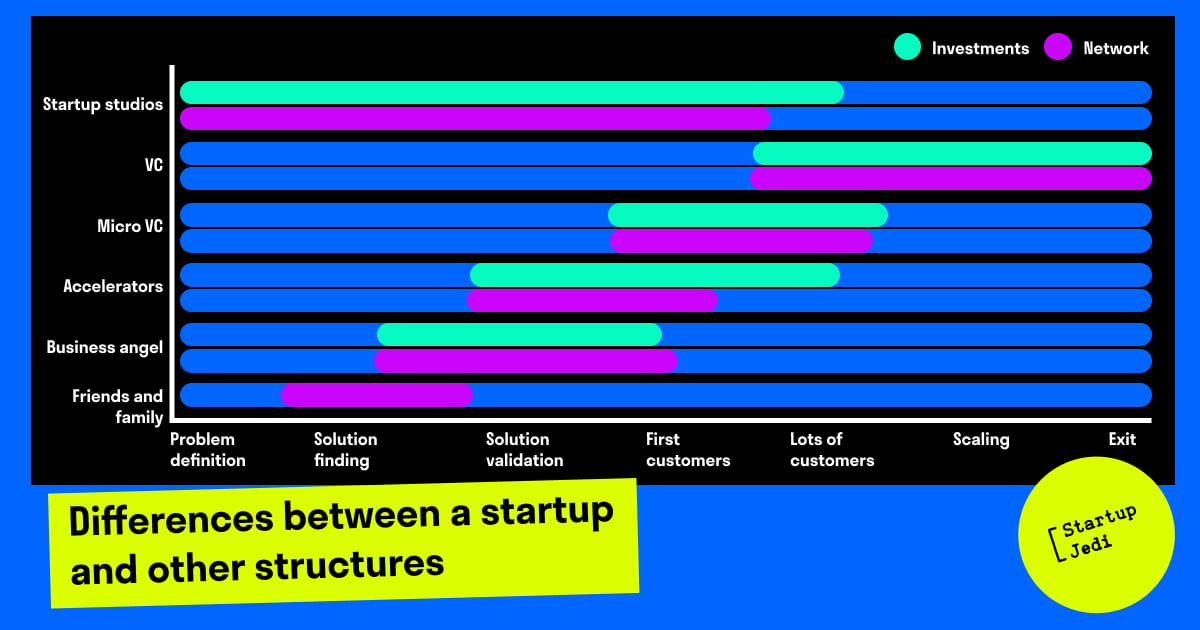
Startup Jedi
We talk to startups and investors, you get the value.

Startup Jedi
We talk to startups and investors, you get the value.
Nowadays startup studios, with the mass production of startups, are in the centre of attention more and more often: they are also called startup factories, venture studios, and venture builders. Although the history of startup studios started long ago — the American company IdeaLab, which became the first “startup production pipeline”, emerged back in the 90s, the real boom of startup studios happened after 2011. Now there are new venture studios popping up around the world literally every month. According to Global Startup Studio Network research, their number will triple in 2023 compared to 2021.

Because this type of work organization is relatively young and there are several interchangeable variations of its name, it may be slightly confusing. Most often, startup studios are confused with accelerators.
...

Accelerators usually work with mature startups that have already validated their MVP and have an established team. Usually, those are the startups that have had their first sales and are scaling up. The goal of the accelerator is to set up an effective “conveyor belt” that the maximum number of startups can go through. Some of them will eventually “take off” and recoup all costs.
Startup studios have a different goal: to constantly grow successful startups, working with them at all stages from the idea to the moment they enter the international market. This is a much larger amount of work and responsibility, as well as a greater level of control over each startup. Atilla Szigetty, co-founder of the Hungarian startup studio Drukka and author of the Startup Studio Playbook makes an interesting analogy. He compares a startup studio to parents bringing up a child, helping them take their first steps, making some decisions for them in the beginning. Accelerators, in turn, are more like a kindergarten, that takes a child for some time, but the parents are still responsible for them.
...

80% of the work in a startup studio is testing a huge number of ideas, identifying the most promising and viable ones, and then building a startup that can use them to make a profit. The same team can test a new product every two weeks, or test 6 -10 ideas in parallel.
According to the founders of the Russian startup studio Admitad Pro, out of 150 initial projects in 2019, 45 reached the stage where they were considered by the studio’s investment team, and then another 80% were screened out in the process of work. Such rigorous screening at an early stage allows getting rid of unpromising projects early on: less than 10% of projects were “killed” after the Seed Round.
Therefore, unlike accelerators, where you still have to go through a fairly rigid selection process, you can come to the studio with a “raw” idea but be prepared that it will be heavily revised. The studio assumes full responsibility for the project, it cannot afford to work on ideas that have no future on the market. That is why startup studios most often specialize in a single market where they have the greatest expertise, whereas accelerators accept startups from completely different industries.
...

Accelerators do not have their own funds: they act as intermediaries, attracting investors and venture capital organizations to the Demo Day selection of startups that they organize. Startup studios, on the other hand, often invest their own money in successful ideas at the first stage. All the resources provided to the team — support from specialists, back-office, workplaces, accounting — are also financed by the studio itself. In addition, venture studios take responsibility for finding investors for the ideas that have been validated. After implementing several successful projects and gaining a good reputation in the market, a studio can get permanent investors who know the startup studio’s team well and are ready to invest in its new projects.
...

Since the startup studio is responsible for the entire life cycle of each startup, it provides the development team with the entire back office for the project: an office with meeting rooms and managers, lawyers, an HR department, marketers, IT specialists, accounting department and trackers. A sales department in a startup studio searches for clients for successful projects. This is much more profitable for the startup studio: several startups can work with one back-office, and in addition, the established team of professionals is more effective in supporting the projects than newcomers. But the main benefit is for the entrepreneurs themselves. To compare, the cost of a month’s work for a similar back office in Moscow (with premises, a lawyer, an accountant, a marketing specialist, an HR specialist and a “salesman”) starts at ₽500 000. And you need all these specialists at the stage when the project is not yet profitable.
Alexander Bespalov, vice president of Investor Relations Club says that legal issues are better developed for studios than for individual projects. The knowledge and expert base accumulated by the studios is also important, especially in a narrow niche — then the growing projects can get a synergistic effect.
...

Time is probably the most important resource for startups and their founders, because dozens, if not hundreds, of teams can be working on the same idea in the world at the same time. A startup works in an accelerator for only a few months, but all that time is devoted to working on one idea; the founding team cannot switch to other ideas (the accelerator program is quite labour-intensive). There is always a risk of the idea failing, in which case the time has been spent in vain.
How does this work in startup studios? The same team works on several projects at the same time, searching until the idea best suited to the market is formed and tested. A team can test a dozen ideas in a year, gaining tremendous experience in their niche, which will help move faster toward Product Market Fit.
Startup studios invest a lot of resources into working with projects. The Admitad Pro team estimates that it costs $1M to produce one startup that passes the break-even point, including back-office work. Speed is a key advantage and value for the startup factory.
...

Let’s get back to the goals again. Accelerators aim to take as many good ready-made ideas as possible, run them through their growth program, and wait for some of them to “take off” and pay off. Startup studios mainly work with human capital, not ideas. Venture studios look for entrepreneurs who will be able to become project founders (ideally serial), develop ideas with the studio’s support, and bring them to fruition. It is the potential of the team together with the experience gained on a huge scale that ensures the studio’s success.
...

The share of an accelerator in businesses is generally up to 10%; the more resources provided, the higher the percentage. Very rarely, the share is as high as 15%. In startup studios, the conditions can be very different and are most often discussed individually with each project. Here, the share can range from 15% to 99% — in fact, some startup studios do not work with projects or entrepreneurs from the outside at all. They nurture ideas solely from within, distributing shares in successful projects between the development team and the studio itself.
If a startup studio does cooperate with outside entrepreneurs and projects, the funder’s contract often mentions an increase in the entrepreneur’s share and a decrease in the startup studio’s share if it develops successfully in the market: this way the founding team has additional motivation to achieve success.
...
Accelerators can be compared to a university, which accompanies you, supplies resources, and trains a “student” at a certain stage of life, the startup studio is a full-fledged adult life and adult business. Everything here is serious, very fast, and geared toward maximum efficiency. This brings results: the Global Startup Studio Network research says that the probability of success after an accelerator for a startup is 21%, and when it leaves the studio it is about 34%.
According to Atilla Sighetti, states have yet to figure out how best to fit the new phenomenon called “startup studios” into their innovation work ecosystem. At the same time, a venture studio owner has no doubt that in a few years, “startup factories” will become as normal and commonplace as accelerators and incubators and will make their significant contribution to the development of technological progress around the world.
ПЛАШКА Accelerators are like universities. Startup studios are more like an adult business
Facebook: facebook.com/StartupJedi/
Telegram: t.me/Startup_Jedi
Twitter: twitter.com/startup_jedi
Comments